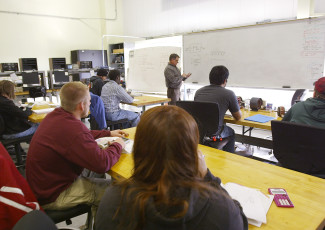4 Lessons from a College’s Completion Efforts
By Dennis Pierce
March 2, 2016
Wallace Community College has transformed instruction, leading to better completion rates. Here’s what campus leaders have learned from the process.
By making the instruction in its most popular courses more active and relevant, Wallace Community College (WCC), in Alabama, has boosted completion rates and closed achievement gaps among at-risk students. Now, leaders aim to build on this success with a campuswide completion initiative called “Getting the Tassel.”
Dean of Instructional Affairs Tony Holland says the changes can be traced back to an analysis of student achievement. “The top third of instructors had 900 more successful students a year than the bottom third had,” Holland says. “When we looked at the strategies they used, it was very obvious why: The top third were using more active learning strategies. We knew we couldn’t close any achievement gaps until we closed this instructor-effectiveness gap.”
To address the problem, the college implemented a dozen high-impact strategies, including the following:
- Adopting early and intrusive intervention for struggling students.
- Using a lecture capture system to post videos of the instruction online, so students could go back and review the material.
- Limiting lectures to 15 minutes per class, followed by discussion, reflection and application of the content.
Putting these strategies into practice had an immediate impact, Holland says: In one year, the college saw a 31 percent increase in the number of students attending class and a 47 percent increase in the number of students who earned a grade of C or better.
Encouraged by these results, campus leaders required the use of these strategies in all developmental courses and in the college’s 10 largest courses by enrollment. They also ramped up their staff development to ensure that all instructors knew how to use these strategies effectively.
The initiative, which is called I-CAN (Improvement, Constant And Never-ending), reportedly has closed 88 percent of the achievement gap between low- and high-income minority students and 79 percent of the gap between low- and high-income non-minorities. What’s more, the college says it has seen a 52 percent increase in completion rates for associate degrees.
To expand on this success, WCC has launched a campuswide program called “Getting the Tassel.” A committee that includes representatives from the entire campus community came up with strategies to promote completion. For example, faculty members wear T-shirts promoting “Getting the Tassel” every Wednesday, and students are asked to sign a completion pledge.
Leading such dramatic change is never easy, and there were a few bumps in the road. Here are four keys to success with college-completion efforts, based on WCC’s experience:
Involve faculty in the process.
“The faculty absolutely had input in coming up with those high-impact strategies we adopted,” Holland says, which helped make the transition smoother. Still, some faculty members resisted at first.
Within those prescribed boundaries, “faculty can do whatever they want,” Holland notes. “We don’t tell them what low-stakes assessments they should use; we don’t tell them what kind of system to use for early, intrusive intervention. We just say you have to have a system.”
Let your data do the talking.
When campus leaders showed faculty members their student outcomes before making these changes, along with data suggesting how much more effective using active learning strategies could be, many resisters became supporters.
Hold staff accountable.
Each semester, faculty members create action plans for how to improve in the areas deemed below standard. And for every professional learning activity, there is a clear follow-through plan. For instance, after a recent leadership training session, faculty members were asked to list three things they took away from the session — and at least one new practice they would implement in their classroom. This practice became a part of each instructor’s action plan.
Don’t wait for 100 percent buy-in.
“Resistance is part of the process,” Holland says. “You just have to work through it.”
If the college had waited until everyone was on board before moving forward, the initiative never would have gotten off the ground. But once it began, and faculty members could see the results for themselves, they started to see more value in it, Holland says.








